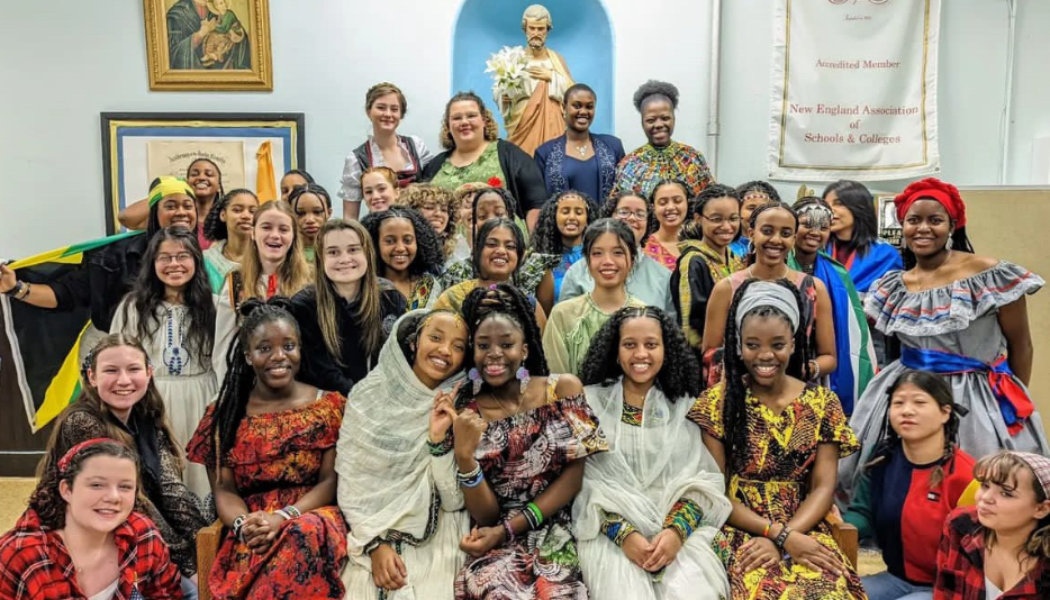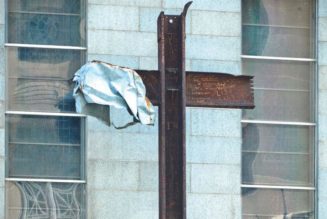The faculty huddle in the narrow lobby of the Academy of the Holy Family in Baltic, Connecticut, as the morning light burnishes the faded yellow walls.
The history teacher, a stoic combat veteran with a special devotion to St. Michael the Archangel for reasons too grave to mention, leans his cane against the sign-in table and his back against the wall.
Sister Stella Maria, of the Sisters of Charity of Our Lady, Mother of the Church, monitors the closed-circuit camera and buzzes in familiar faces. She credits her ability to see her fellow sisters as “just people” to her late-life vocation. She’d lived a long life before this, and so she isn’t surprised by much.
At last, Mother Mary Mark of the Sisters of Charity, a graduate of the Academy of the Holy Family in the 1960s, shuffles in, prayer card in hand. She takes a chair against the wall and makes the Sign of the Cross, her feet barely scraping the floor. The faculty bow their heads and listen while the maintenance men drift toward the entryway and remove their ball caps.
Mother Mary Mark recites the prayer as if it were a poem, the note of her voice bouncing with the meter.
Sister of Charity Mary Jane, the Vietnamese math teacher, reads the morning announcement: The Marist Royals, the academy’s varsity basketball team, are the subject of a feature in CT Insider.
Not for being a great basketball team, of course — the Royals have only one standout player, a wunderkind from Rwanda named Chanelle (the CT Insider article spelled her name “Channel”), and they’d just returned to the league after a four-year hiatus due to low enrollment.
The article is about how charitable the other team had been to these “charity cases” to offer them a spot on their game schedule. The academy is run by the Sisters of Charity, and most of the girls are from poor countries: Ethiopia, Rwanda, Haiti; etc. The article is all about “charity.”
True Scholars
“Aren’t you those famous girls I read about in CT Insider?” I tease as students trickle into my room for first-period “Senior Literature.”
“Oh my days,” a Belizian girl named Jas says. “You’re tripping, Mr. Laffin.”
“That’s not it, Mr. Laffin,” says a Botswanan girl named Akyini. (“Not it” means “not cool” in Gen Z-an.)
“You don’t think it’s even a little cool that you were in an article?” I ask once they’re settled at their desks.
They shoot each other looks. The kindest girl in class, Cora from Arizona, who is in the process of discerning a vocation to the Sisters of Charity, lowers her eyes to avoid being called on. It’s always a dead giveaway that she has something interesting to say.
“What am I missing, Cora?”
“Well, Mr. Laffin, it’s just that we don’t like the article,” she says, scanning the room to see if her classmates want her to continue. “We don’t like to be pitied.”
I’m speechless for a moment. At first, I’m just confused — after all, what teenagers don’t like to be pitied? A sudden outpouring of pity was second only to a surprise trip to Friendly’s, a local family restaurant chain known for its ice cream, when I was a kid.
And yet, these girls in my class — some of whom can make a stronger claim on pity than anyone I’ve ever known — won’t touch the stuff.
As I wait for more of an explanation, I’m suddenly overcome by the best feeling a teacher can have: a sudden and joyful flood of admiration for my students. Following 16 years on the job, I can attest that there’s nothing greater.
These girls, it strikes me, in addition to being some of the best students in the country — they are each going to end up with more degrees than a thermometer if their test scores and scholarships are any indication — these Marist Royals of the Academy of the Holy Family have character. Real Christian character.
“If I had a daughter, I’d send her here,” I say in a sudden fit of inspiration. “I’d want her to be friends with all of you.”
They squirm, embarrassed. Jas calls me lame, but with a smile.
I see the compliment settle on their faces, which is good, because I mean it.
We begin the day’s lesson, a review of a chapter from Graham Greene’s The Power and the Glory. We talk about the whiskey priest and what Greene is trying to say about what it takes to be a saint.
Enduring Lessons
The 2023-24 school year was my only one at Academy of the Holy Family. The currents of fate that tossed me into her hallways drew me back just as quickly.
But I’ll be spending many years contemplating this good tree to understand how it yields its fruit.
Only a few months removed, here’s what I’ve got:
- The academy is run by religious sisters who devote every drop of blood in their hearts to the work Christ gives them. The sisters are, of course, “just people,” as Sister Elizabeth Maria would say, but they are single-minded in purpose, whip-smart, and eager to laugh with the girls. The motto of the school is “where friends become family” — and it’s true.
- The students, sisters and teachers pray together all day long: before class, before meals, during Mass, at the dorms, and often spontaneously. The effect of lifting the heart of the community to the Light of God so often produces a weightlessness, a lightness of heart, that is uniquely conducive to learning.
- The building is old and the amenities are behind the times, but everything is beautiful. The grounds, set in the rolling hills of rural Connecticut, are incredibly so, as is the chapel. This year marks the school’s 150th anniversary, and you can feel a tangible connection with the past there.
- The lay faculty are highly competent and committed to forming the souls of the students as much as their minds. They aren’t dogmatic about any particular theory of education but are simply committed to meeting students where they are and helping students from diverse backgrounds and skill levels succeed.
- Nearly every student participates in multiple clubs, including a pro-life club, multicultural club, human-rights club; etc. The drama club put on an inspired performance of The Phantom of the Opera last year. The choir will move your heart during Mass.
- Perhaps the greatest strength of the school is the — wait for it — diversity, which, I believe can only be a strength if it is grounded in a unity greater than the sum of its parts: namely, Jesus Christ.
The academy is a true international school, though it also has students from across the United States. Each year, the young women celebrate “International Day,” during which they dress in traditional garb and perform elaborate dances and cook ethnic meals. The day was, perhaps, the most truly “educational” day I’ve ever experienced in a school.

If you’re a parent in search of a high school for your daughter that will form her into a powerful young Catholic woman of character and intelligence, contact [email protected].
My guess is you’ll leave the conversation with the same feeling I had upon clearing out my classroom a couple of months ago: blessed and hopeful.









